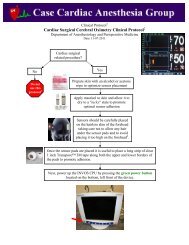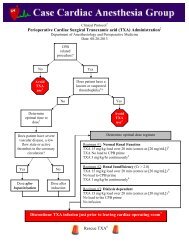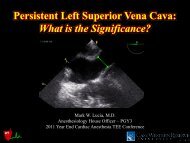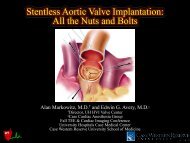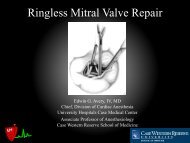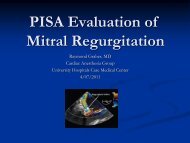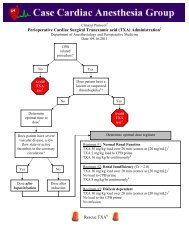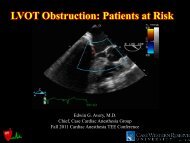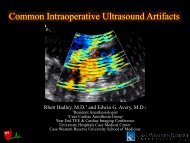Pre-Cardiopulmonary Bypass Transfusion Guideline - Casecag.com
Pre-Cardiopulmonary Bypass Transfusion Guideline - Casecag.com
Pre-Cardiopulmonary Bypass Transfusion Guideline - Casecag.com
You also want an ePaper? Increase the reach of your titles
YUMPU automatically turns print PDFs into web optimized ePapers that Google loves.
Clinical <strong>Guideline</strong>s †<strong>Pre</strong>-<strong>Cardiopulmonary</strong> <strong>Bypass</strong> <strong>Transfusion</strong> <strong>Guideline</strong> for Cardiac Surgery ‡Department of Anesthesiology and Perioperative MedicineDate: 11-03-2012Cardiac Surgeryrelated procedure?NoYesAvoidthese<strong>Guideline</strong>s<strong>Pre</strong>operative Central Lab & TEGBaseline Coagulation StudiesAbnormalNormalNo transfusion indicated45
†Clinical guidelines are based on the best and most recent available data and are made available to promote bestclinical practices and to an extent to standardize our approach to managing various clinical issues that areencountered by all CASECAG staff. Standardizing our approach to some of our practices is expected to reducemedical errors in the clinical environment and increase work flow for the trainees.‡These clinical guidelines are intended to reduce the risk of excessive microvascular bleeding following CPBrelated cardiac surgery and to reduce the over transfusion of non-red blood cell allogeneic blood <strong>com</strong>ponentsthat is routinely associated with the management of bleeding without the use of transfusion algorithms. 5-81: The rapid administration of any citrate containing blood products can precipitate an acute hypocalcemia thatmay present clinically as seizures, bronchospasm, congestive heart failure and prolonged QT interval.Therefore, if a substantial amount of FFP (i.e. > 2 units) is going to be added to the CPB prime then cautionshould be taken to transfuse the FFP slowly to avoid the clinical symptoms associated with acutehypocalcemia. One suggested technique is to administer 2 units of FFP into the CPB prime and thenfollowing initiation of CPB check the ionized Ca ++ concentration. If it remains within the normal range thenslowly transfuse the other FFP units with frequent checks of the ionized calcium concentration. IVsupplementation of calcium may be indicated but take caution not to infuse the CaCl too rapidly if the heart isarrested as the Ca ++ acts like a positive inotrope and can increase MVO 2 and thus threaten myocardialprotection.2: The elevated INR, aPTT and R-time may indicate significant depletion of soluble coagulation factors, aproblem which should be anticipated to worsen following initiation of CPB. Therefore, it is prudent to thaw2-4 units of FFP and have it available for immediate transfusion following separation from CPB andprotamine administration. No FFP should be transfused until a post-protamine TEG and/or central labs areavailable unless severe microvascular bleeding is apparent.3: The optimal timing of when one should add the FFP to the CPB circuit has not been established. Points toconsider when determining when to add FFP to the CPB circuit are as follows:a. Adding the FFP early (i.e. in the CPB prime fluid) will prevent further consumption of the alreadydepleted soluble coagulation proteins as even with optimal heparinization there will be consumptionof these proteins as heparin only effectively blocks factor X and to a lesser extent II. This means thatall of the serine proteases before and in between these steps in the coagulation cascade will beactivated to some extent and factors will be consumed despite the fact that visible clot is not beingformed.b. Adding the FFP to the CPB circuit prime will leave it vulnerable not only to consumption but also tohemodilution when and if additional fluids are added to the CPB circuit.c. Adding the FFP to the CPB circuit later in the pump run mitigates both consumption andhemodilution of the soluble coagulation proteins and may make more of these factors available toparticipate in coagulation following separation from CPB and heparin neutralization.d. Adding the FFP to the CPB circuit later in the pump run may result in suboptimal heparinization asthe serine protease, Antithrombin III, is required as a cofactor to heparin and may very likely bedepleted also if the aPTT, R time and/or INR are elevated. Suboptimal heparinization wouldpotentially result in more consumption of existing coagulation proteins and more microvascularbleeding post-CPB. A clue to AT III depletion is heparin resistance pre-CPB.e. Regardless of when the FFP is added to the CPB circuit it will not <strong>com</strong>pletely obviate the need fortransfusion of FFP following CPB separation and heparin neutralization so additional FFP should beimmediately available following CPB separation for patients with abnormal INR, aPTT and R values.
4: As a general rule one vial of fibrinogen concentrate contains approximately 1100 mg of fibrinogen which isroughly equivalent to the amount of fibrinogen contained in 5 units of cryoprecipitate or 5 units of FFP.Using the formula below a specific target blood fibrinogen concentration can be calculated if desired. Limiteddata exist to suggest that any one fibrinogen level is optimal, thus TEG Angle guided administration offibrinogen appears clinically prudent.References:5. Shore-Lesserson L, Manpeizer HE, DePerio M, et al. Thromboelastography guided transfusionalgorithms reduces transfusions in <strong>com</strong>plex cardiac surgery. Anesth Analg 1999;88: 312-96. Nuttall GA, Oliver WC, Santrach PJ, et al. Efficacy of simple intraoperative transfusion algorithm fornonerythrocyte <strong>com</strong>ponent utilization after cardiopulmonary bypass. Anesthesiology 2001;94:773-817. Royston D, Von Kier S. Reduced haemostatic factor transfusion using heparinase-modifiedthromboelastography during cardiopulmonary bypass. Brit J Anaesth 2001;86(4):575-88. Avidan MS, Alcock EL, Da Fonseca J, et al. Comparison of structured use of routine laboratory tests ornear patient assessment with clinical judgment in the management of bleeding after cardiac surgery. BritJ Anaesth 2004;92(2);178-86



